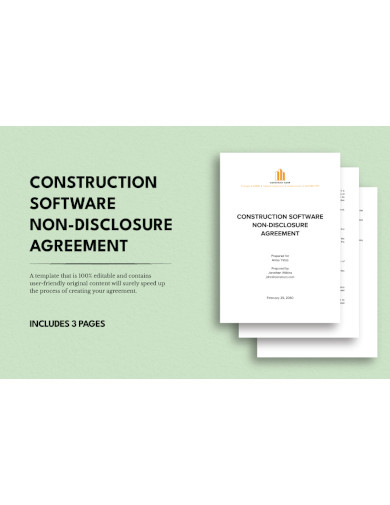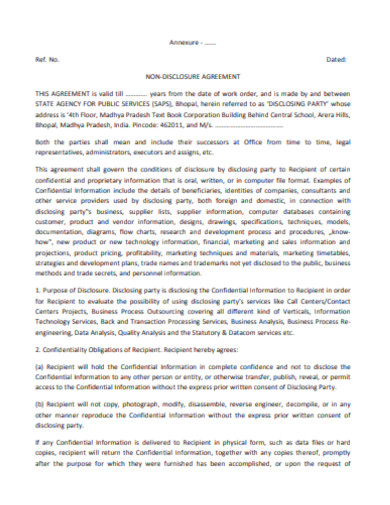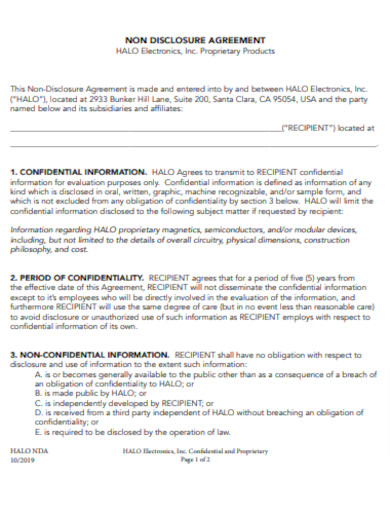A Sales Agreement is a vital legal document that outlines the terms and conditions of a transaction between a buyer and a seller. It defines the rights, obligations, and…
continue reading
25+ SAMPLE Construction Non Disclosure Agreement
-

Construction Subcontractor Non-Disclosure Agreement
download now -

Construction Software Non-Disclosure Agreement
download now -

Construction Manager Non-Disclosure Agreement
download now -

Construction Investor Non-Disclosure Agreement
download now -

Construction Non Disclosure Subcontractor Agreement
download now -

Construction Non Disclosure Agreement
download now -

Construction Independent Contractor Non-Disclosure Agreement
download now -

Construction Employee Non-Disclosure Agreement
download now -

Construction Subcontractor Non-Disclosure Agreement
download now -

Construction Confidentiality Non-Disclosure Agreement
download now -

Simple Construction Non-Disclosure Agreement
download now -

Construction Mutual Non-Disclosure Agreement
download now -

Construction Personal Confidentiality Non-Disclosure Agreement
download now -

Sample Construction Non-Disclosure Agreement
download now -

Construction Non-Disclosure Agreement Outline
download now -

Editable Construction Non-Disclosure Agreement
download now -

Construction Non-Disclosure Proprietary Agreement
download now -

Construction Non-Disclosure Contractor Agreement
download now -

Construction Non-Disclosure Agreement Layout
download now -

Construction Supplier Non-Disclosure Agreement
download now -

Construction Program Non-Disclosure Agreement
download now -

Printable Construction Non-Disclosure Agreement
download now -

Construction Non-Disclosure Agreement Format
download now -

Construction Non-Disclosure Confidentiality Agreement
download now -

Standard Construction Non-Disclosure Agreement
download now -

Professional Construction Non-Disclosure Agreement
download now
Definition:
A Construction Non-Disclosure Agreement (NDA) is a legally binding contract between parties involved in a construction project, ensuring that proprietary information, plans, or trade secrets shared are kept confidential. It prohibits unauthorized disclosure or use of shared data, safeguarding business interests, and maintaining trust in construction-related collaborations and negotiations.
Construction Non-Disclosure Agreement: An Essential Guide
In the vast world of construction, information is a vital asset. Whether it’s a new building technique, a unique design, or a proprietary piece of software, keeping trade secrets safe can be the difference between standing out in the industry or getting left behind. Enter the construction non-disclosure agreement (NDA), a tool every construction business should be familiar with. This guide delves deep into its intricacies.
Why Every Construction Project Needs an NDA
Confidentiality in the construction sector cannot be overstated. With high stakes in terms of cost, time, and intellectual property, ensuring that sensitive information remains within the designated circle is paramount. NDAs provide that security blanket, ensuring:
Protecting Intellectual Property:
Every construction project involves a plethora of unique designs, plans, and strategies. An NDA ensures that these intellectual assets remain confidential, preventing unauthorized sharing or replication.
Preserving Business Interests:
Construction companies often have trade secrets or business strategies that give them a competitive edge. An NDA safeguards these secrets from being disclosed to competitors or used against the company.
Fostering Trust Amongst Parties:
When an NDA is in place, parties can communicate more openly, knowing that proprietary information will be kept confidential. This trust can facilitate smoother project progression and better collaboration.
Mitigating Legal Risks:
Should a breach of confidentiality occur, a well-drafted NDA provides a legal framework for seeking remedies. It offers clarity on what constitutes a breach and the consequences thereof.
Encouraging Professionalism:
An NDA instills a sense of responsibility and professionalism among stakeholders. It reinforces the idea that every piece of information related to the project must be handled with care and discretion.
Setting Clear Boundaries:
With an NDA, all involved parties understand the limits of what can and cannot be shared, discussed, or replicated outside of the project. This clarity can prevent unintentional slips and breaches.
Key Elements in a Construction NDA:
To be effective, an NDA must be precise. Here are the core components to consider:
Definition of Confidential Information:
It’s paramount to explicitly define what constitutes confidential information. This could range from blueprints, cost estimates, to client details and proprietary techniques.
Duration of Confidentiality:
Specify the time frame for which the confidential information must remain secret. This could be for the duration of the construction project and a few years thereafter or until the information becomes public knowledge.
Obligations of the Receiving Party:
Clearly outline the duties of the party receiving the confidential information. They should not disclose, reproduce, or use the information for any purpose other than the agreed project.
Exceptions to Confidentiality:
Not all information will be confidential. The agreement should list exceptions, such as information already in the public domain or information independently developed without reference to the confidential data.
Return or Destruction Clause:
Upon completion of the project or termination of the agreement, stipulate that all confidential materials, including copies and notes, should be returned or destroyed.
Non-Circumvention Clause:
This prevents the receiving party from bypassing the disclosing party and directly approaching or dealing with persons or entities introduced or disclosed as part of the project.
Remedies for Breach:
The NDA should detail the consequences if a party breaches the agreement. This could include monetary damages, injunctions, or both.
No Transfer of Rights or Licenses:
Clarify that the NDA doesn’t grant any license or rights to the receiving party, other than the right to use the information for the project.
Non-Compete Clause (Optional):
While not always present, some NDAs may include a non-compete clause to prevent the receiving party from entering into competing projects or contracts using the disclosed information for a specified period.
Drafting a Foolproof NDA
The strength of an NDA lies in its wording. It’s advisable to:
Understand the Purpose:
Before drafting, clarify the reasons for the NDA. Is it to protect sensitive architectural designs, financial projections, client lists, or construction methods? The purpose will guide the scope of the agreement.
Be Specific with Definitions:
Don’t use broad strokes when defining confidential information. Instead, categorize and itemize, ensuring both parties know exactly what’s protected.
Set a Reasonable Duration:
While you’d want to keep secrets forever, it’s essential to set a realistic timeframe. Anything overly lengthy might be unenforceable in court.
Outline Obligations Precisely:
List out the obligations of the receiving party comprehensively. For instance, specify the conditions under which they can disclose information, such as when required by law.
Exceptions to the Rule:
Clearly mention situations where the agreement doesn’t apply. This could be for information already known to the public or the receiving party.
Address Third-Party Involvements:
State the rules about sharing confidential data with third parties, like subcontractors or consultants. Can the receiving party share the information with them? If so, under what conditions?
Decide on Remedies:
Be clear on the repercussions of a breach. While monetary penalties are common, you might also consider other remedies like injunctions.
Jurisdiction Matters:
Always include a clause specifying the governing law and jurisdiction in case of disputes. This ensures any disagreements are resolved under predictable legal standards.
Regular Reviews:
Like any other contract, periodically review and update your NDA to ensure it remains relevant, especially in an ever-evolving industry like construction.
Seek Legal Counsel:
Even if you’re drafting the NDA yourself, it’s always a wise idea to have it reviewed by a legal expert. They can spot potential pitfalls and make necessary adjustments to ensure enforceability.
Common Pitfalls to Avoid:
An NDA’s effectiveness can be compromised if not approached correctly. Here’s what to sidestep:
Overly Broad Definitions:
Avoid defining confidential information in such expansive terms that it becomes impractical. An overly broad definition can make the NDA unenforceable or lead to unintentional breaches.
Ignoring the Duration:
An indefinite NDA duration is not only unrealistic but can also be unenforceable. Specify a clear timeline that balances protection with practicality.
Failing to Address Third Parties:
If third parties like subcontractors or consultants aren’t explicitly addressed, there’s a potential risk of them accessing confidential data without being bound by the NDA’s terms.
Neglecting Return or Destruction of Data:
Forgetting to include clauses about the return or destruction of data once the agreement concludes leaves a loose end that could result in data breaches.
Ignoring Jurisdictional Clauses:
Without a specified jurisdiction, resolving disputes can become a nightmare. The parties might end up in different courts, leading to prolonged and costly legal battles.
One-Size-Fits-All Approach:
Using a generic NDA template without tailoring it to the specifics of the construction project or relationship can lead to inadequate protection.
Overlooking Non-Compete Clauses:
While NDAs primarily focus on confidentiality, sometimes there’s a need to prevent parties from using the knowledge gained to compete. However, ensure non-compete clauses are reasonable in scope and duration.
Not Regularly Reviewing:
Failing to periodically review and update the NDA can lead to outdated terms that don’t address current needs or reflect industry changes.
Not Securing Mutual Protection:
While often an NDA protects the disclosing party, there might be situations where both parties exchange confidential information. Ensure mutual protection to maintain trust.
Skipping Legal Review:
Relying solely on templates or drafting without legal expertise can lead to overlooked vulnerabilities. Always consult with legal counsel to ensure your NDA is comprehensive and enforceable.
Best Practices for Implementing NDAs in Construction:
To optimize the effectiveness of NDAs:
Establish a Standard Process:
Having a standard procedure for when and how to introduce NDAs ensures consistent protection across all projects and interactions.
Customize for Each Project:
While a standard NDA template can serve as a foundation, tailor the agreement for each project’s unique requirements, ensuring all specifics are covered.
Secure Early Signatures:
Always obtain NDA signatures before disclosing any confidential information. It’s preferable to have these signed at the beginning of any negotiation or discussion.
Determine Duration:
Specify how long the NDA is in effect. While some information might need protection indefinitely, other data may only require confidentiality for a set period.
Address Third-Party Disclosures:
Recognize that subcontractors, suppliers, or consultants might need access to confidential information. Ensure the NDA binds them, or they sign separate agreements.
Review Jurisdiction and Dispute Resolution:
Clearly mention the jurisdiction under which any disputes related to the NDA will be resolved. Consider including arbitration clauses to streamline dispute resolution.
Monitor and Enforce Compliance:
Regularly check that all parties are adhering to the NDA’s terms. Quick action on minor breaches can prevent more significant issues down the road.
Periodically Review and Update:
As industry standards and technologies evolve, your NDA might need updates. Review and modify it as necessary to ensure continuous protection.
Maintain Digital Records:
In the digital age, having easily accessible digital copies of all NDAs ensures quick reference when needed, aiding in transparency and accountability.
Foster Open Communication:
Promote a culture where employees and partners feel comfortable raising questions or concerns related to the NDA, ensuring clarity and minimizing unintentional breaches.
Why is an NDA crucial for construction projects?
An NDA (Non-Disclosure Agreement) is crucial for construction projects to protect proprietary methods, cost structures, client details, and unique designs from unauthorized disclosure. It ensures that sensitive information remains confidential, safeguards competitive advantages, and fosters trust between contractors, clients, and subcontractors, minimizing potential disputes and unauthorized information leaks.
What are the potential consequences of breaching a construction NDA?
Breaching a construction NDA can lead to legal actions, financial penalties, and damage to reputations. Consequences include monetary damages for losses incurred due to the breach, injunctions preventing further disclosures, potential termination of contracts, loss of business opportunities, and a tarnished reputation in the construction industry.
How are damages or remedies for breaches determined in the agreement?
In the agreement, damages or remedies for breaches are often pre-defined as either liquidated damages, which specify a set amount, or actual damages, which require quantification of actual losses incurred. The NDA may also provide for injunctive relief, attorney fees, or alternative dispute resolution mechanisms like arbitration or mediation.
Can both parties be bound by confidentiality in a mutual NDA?
Yes, in a mutual NDA, both parties are bound by confidentiality. This means each party agrees not to disclose or use the other’s confidential information improperly. Mutual NDAs are common in situations where both parties will be sharing sensitive information, ensuring protection for both sides proprietary details.
When should NDAs be reviewed and updated in the construction industry?
In the construction industry, NDAs should be reviewed and updated whenever there are significant changes in the nature of the information being shared, evolving industry regulations, or when entering new partnerships or projects. Regular reviews, at least annually, are also advised to ensure the agreement remains relevant and compliant with current laws.
In conclusion, the construction non-disclosure agreement is an indispensable tool in preserving a company’s trade secrets and proprietary information. Emphasizing construction confidentiality and industry best practices, such an agreement fortifies trust between parties and promotes a culture of respect for intellectual property. Ensure your firm’s competitive advantage by implementing a robust NDA.

